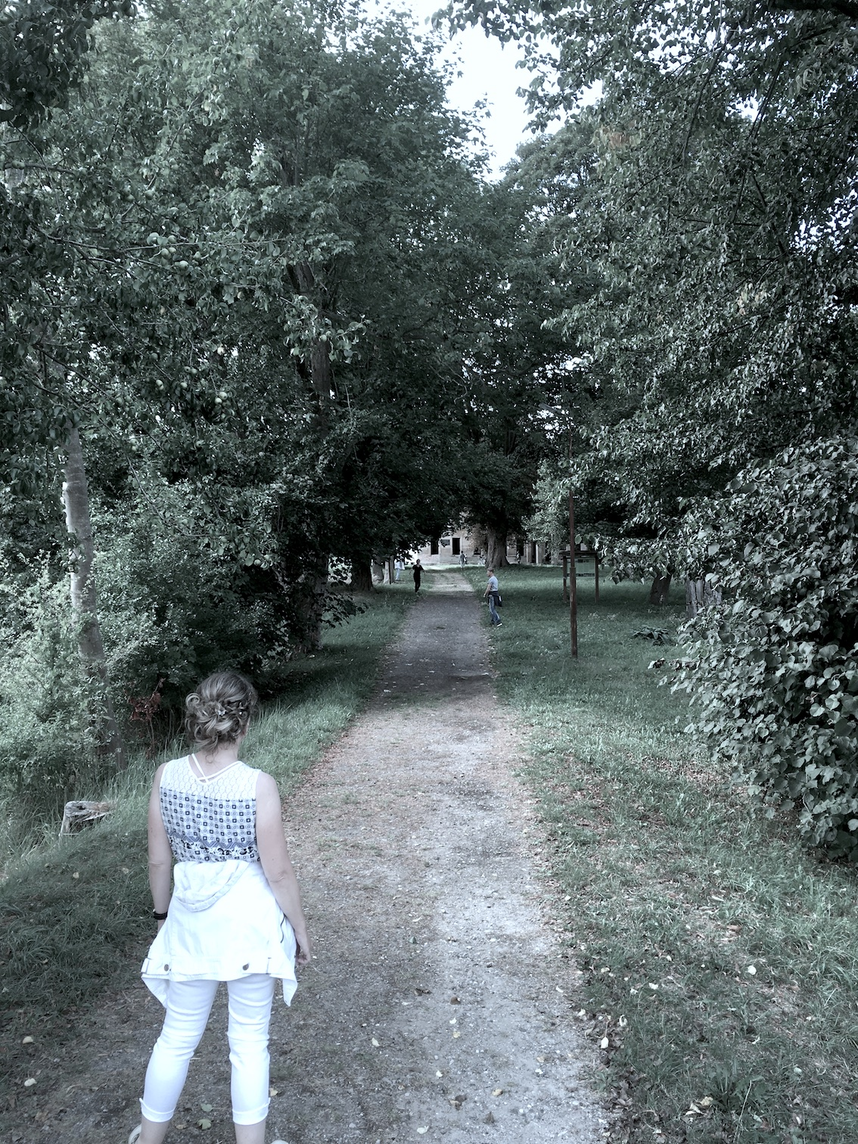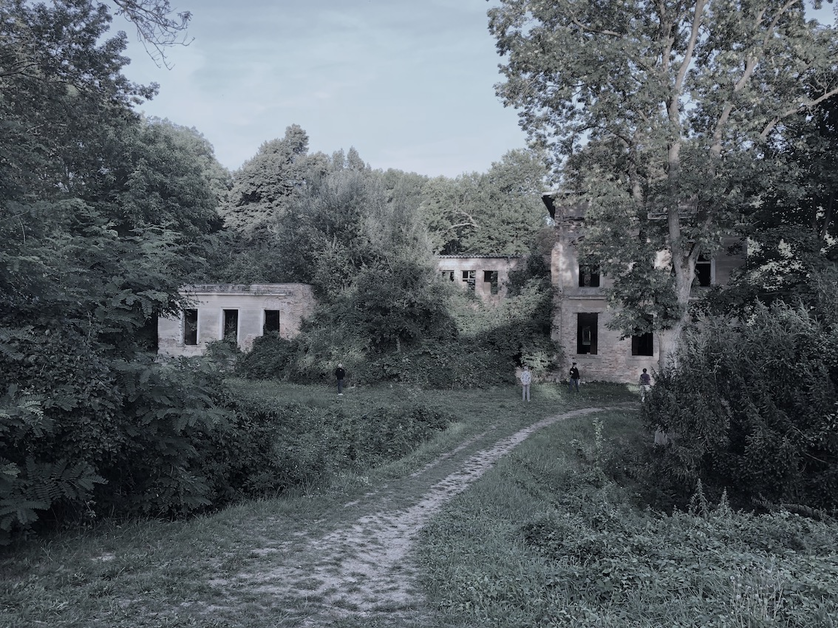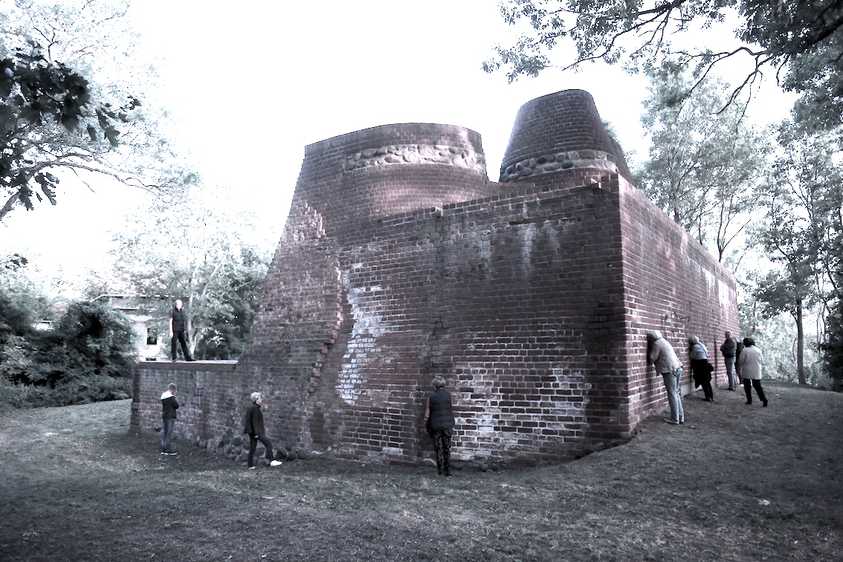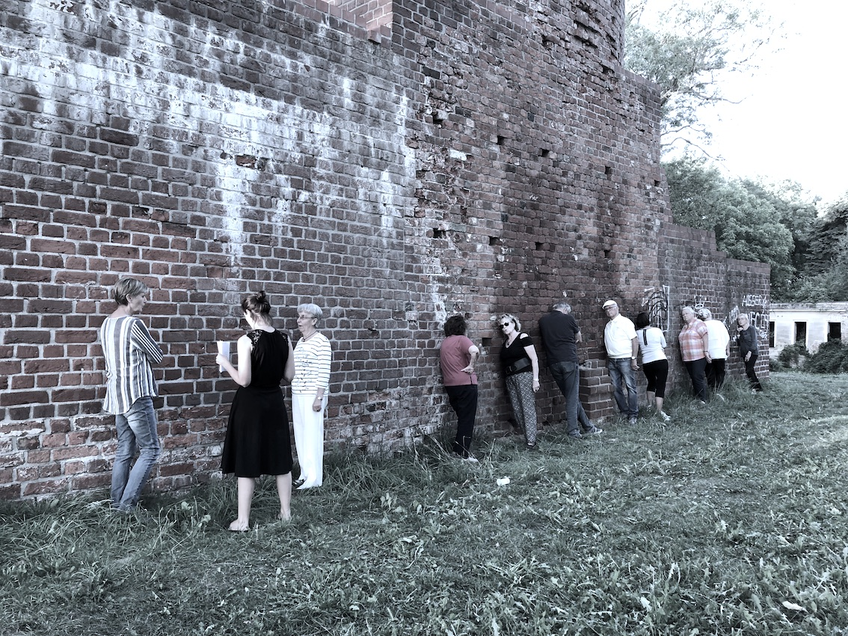Site
When I create spatial music performances, I always start from the site. My practice is related to site and informed by site. There are no concrete plans or preconceived ideas before this encounter. Everything derives from the dialogue with the site. This project engaged with the city of Demmin at large, and more specifically with the estate of Haus Demmin, and was developed in close dialogue with the Peenechor choir. The location, its architecture and the participation of the choir were the main factors that framed how a composition with voices could develop there.
The content that developed on site and the stories that were told during our shared time could only surface here. The focus on a certain place strongly influences what stories can be remembered and told. These stories were both collective and individual. The conversations also brought up old local fairy tales connected to the two buildings. Although these fairy tales are written down, they are fast slipping out of the local collective memory. In this project the fairy tales took on importance as they form a bridge between the now and earlier history. They also reimagine the buildings as they were way back in time; when they were new, vivid and at the centre of local life. As witnesses the participants brought the contemporary and the past together. With their varied backgrounds and relationships to Haus Demmin the singers offered multiple perspectives. Additionally, the buildings themselves, in their present state of decay, marked and scarred by time, allowed for a wide range of perspectives to emerge.
Another important factor in this particular spatial composition was that of selection. Brian Eno discusses emergent systems in creative processes, where the environment acts as a 'variety-reducer', selecting certain strains and allow them to survive and reproduce, while filtering out others (Eno, 1996, p. 334). In this project we investigated which sounds were in some way supported by the remaining architecture and the surroundings. Through the exercises we tried a lot of vocal sounds: some persisted and were developed, others faded away. The situation at Haus Demmin emphasised strongly what I had already experienced in earlier projects that took place within indoor spaces, exploring acoustic interaction between voice, sound and architecture. When working with acoustic sound then sounding itself is one thing, while the ability to be heard is another. In this open-air performance the question of what is audible relates to what I call the body of the sound. The body of sound is a definition that I work with in order to illustrate sound's materiality, and to find a tactile expression for its temporal, mouldable physicality. It acknowledges that the transparent body of sound is not shapeless. The body of sound is, rather, a shapeshifter that develops over time. Consequently, it is not necessarily the volume that decides if a sound has presence. It is how the body of sound moves and negotiates with spatial factors that establishes its audibility.
For my site-sensitive works I am drawn to the idea of the site becoming a co-composer, by selecting what sounds can "take place" here. This relates to the term 'site-determined' that Robert Irwin coined; where "the sculptural response draws all its cues (reasons for being) from its surrounding". (Irwin, Weschler, Pace Gallery., & San Francisco Museum of Modern Art., 1985, p. 572) The state of decay at Haus Demmin stimulated a thorough engagement with the changed surfaces and the altered textures of the building elements. The traces of decay in process are visible and invisible, but both kinds influence the sound. The alteration through time changed the acoustic character of the buildings. These altered acoustic qualities then began to define the kinds of sounds that they could support, and how they would be influenced by the remains of the structure.
Un-unlistening
When I guide an engagement with a site, I do so through listening. Composer and musician Pauline Oliveros distinguished between hearing and listening. "To hear is the physical means that enables perception. To listen is to give attention to what is perceived both acoustically and psychologically." (Oliveros, 2005, p. 6) In my workshops we listen attentively together. This practice makes us aware of the many layers of sound and sound events that we have previously ignored and not payed attention to. We become aware of what was previously unlistened, a different state to something being unheard. Even though we might have heard all the sound events that surround us, they were not previously listened to.
We cannot close our ears the way that we can our eyes. Sometimes we deliberately filter out sound by holding our hands to cover our ears or more recently by using noise cancelling headphones. But most of the sound that we don’t listen to is filtered out without us ever being aware that it is even happening. Subconsciously, most of the sound that we hear is never forwarded to our listening attention at all, it is unlistened. An important exercise in projects such as Demmin - eine Stadt zum Klingen bringen is to undo this unconscious unlistening.
In listening exercises with the participants, I ask them to follow the drift of their attention. As we do this our focus expands until it is broad and inclusive, and gradually each participant drafts his/her own sound map of the site and the surroundings. When we later share our individual experiences each map gets expanded further by the input of the others. Sites are alive. The site is in an ongoing state of drift, change and transformation. Our understanding of the site changes over time, and these changes reciprocally influence each other. Listening exercises make it evident that in an open-air space like Haus Demmin the surrounding sound environment changes continuously throughout the day. Accordingly, the sound maps are never fixed and never finished. We need to stay aware, keep on listening for what was unlistened on site throughout the whole duration of the project.
Voicing stories, overcoming silence
We all carry many stories. Some of them we don't tell because to share them would be uncomfortable. Many we don't share because we think that they won't be of interest to others. As I was in dialogue with residents of Demmin I came to realise that the city is to a large extent created through the stories of those living there. When you arrive as a visitor in a city it's easy to think that the city is just the city, but when you start talking to locals and they share their stories you realise that there is also another city present, an invisible city. When they spoke about their lives there, places that previously seemed insignificant to me were now imbedded in a story. Stories change our view into places. When stories are shared, we can connect in new and different ways to the places and to the people who know the story. In the case of Demmin, where certain stories are reinforced by being retold again and again, this power of stories leads to a stagnation in the identity of the city.
When we shared stories of Haus Demmin – including fairy tales, saga and memories – through the vocal music developed on site, the two buildings took on meanings other than those caused by wars and occupations. They became versatile. And the broad set of stories allow for a wider imagination as to what they might be in the future. The many stories associated with the buildings and revealed through storytelling unfold the interconnectedness of place and inhabitants. The many meanings a place has for its residents develop through human storytelling – not just through the one history that is repeatedly reinforced.
Even though for a long time I thought that such a thing would be impossible, in Germany today we are in danger of re-writing certain histories. The project in Demmin came to mean more to me than only an exploration of voice and historic buildings in the open air. When we listen to voices that we don't usually hear publicly any more, like the voices and stories of the elderly people of Demmin, we also come to carry their stories and they become a part of our memory. This made the urgency of storytelling clear to me. Publishing (in the original sense of 'making known in public') different stories and memories is important as it problematises "the truth". In Demmin the reinforcement of the 1945 trauma has remained an open wound, casting the city in a collective depression. Diversifying the city's stories opens new prospects for the future. At the same time there is a need to balance the resistance to forgetting with the rewriting of history such that it might repeat itself.
Participants – The ageing voice
I usually work with singers that are residents of the place where the pieces are developed. It is their connection to the place that informs content and context. The material (stories, history, memory, images and vocal expressions) emerge through conversations, interactions and explorations with the singers. During the vocal explorations on site the focus lies on the body of sound, the movement of sound, the relation the singers have with the sounds they create and the dialogue the singers can have with their immediate surroundings through voice.
These investigations are not concerned with classical ideals of beauty. I work with singers and musicians of all ages, and very often they are not professionally trained but instead dedicated amateurs. Brian Eno writes in his text "The Great Learning", about the Cornelius Cardew piece of the same title,that the trained musician gives up "some of his natural variety (…) to increase his reliability (predictability)". (Eno, 1996, p.334) I do not prioritise a homogeneous sonic character among the voices that participate in my works. Instead I embrace the individual vocal expression of each participant as this supports in turn the individual experience and character of each performer.
The qualities of the ageing voice could be understood as a limitation, due to breathiness, difficulties in holding a tone, audible friction, cracking of the voice and so on. They were, however, a reciprocal blessing for the project because the remains of the buildings on site grew in importance. In some workshop situations we moved so close to the old stones of the tower that it was not clear to us any more if it was the voices sounding, or if this was the stones singing.
In my spatial music compositions fragility plays an important role. Sound as such is fragile in its fleetingness. I see a quality in the delicate and vulnerable. There is a beauty in the ephemeral presence of voice. As humans we are attentive to the sound that a human makes, to a sound that is human, and as humans ourselves we are therefore always and already connected to it. I am fascinated by breath. In the ageing voice breath becomes more present, what is called the "breathy voice". This is due to the fact that a gap starts developing where the thinned vocal chords can no longer close completely. We used this quality several times when in dialogue with the architecture at Haus Demmin. The dialogue became more physical, both through the proximity to the buildings and in the way that the body of the singers became audible in their voice.
Audience
The audience for this work were local citizens from Demmin and the neighbouring villages. Many of them combined a bike trip organised by the city with a stop for the performance at Haus Demmin. As they entered I greeted them by the small bridge that leads over the river Tollense to Haus Demmin and gave them an introduction to the project and its context before they entered the listening experience. For the local audience to visit a place that was known by most but by many forgotten or not visited anymore held the possibility for another listening. I would describe it as a parallel listening. The audience could simultaneously engage with other stories and their own memories connected to the place.
The audience could walk freely but were guided along the unfolding sound path by the voices of the choir. The audience was explorative and would move around and experience different perspectives during the different parts. When I create spatial performances it is a common pattern that part of the audience decides to moves towards the walls and stay there for the duration of the performance. Outdoor, in the open and with the absence of walls, it was an interesting experience to find that the sound and its reach would outline the limits of the shared space.
It was important for this project that storytelling as an aural tradition stayed aural in its form of expression. Indeed, after the presentation many stayed behind and shared memories with each other that were triggered by the performance. These different forms of vocal expressions carry the potential to stimulate a continuation of story-sharing, and may help overcome silence.
Sense of community
Communities share the same environment and interests. If we create a common sound place informed by stories, can we create a community? And if we create a temporary community through a workshop and during a performance, how can this become part of the enduring community?
Voices and buildings as dialogue partners have presence, and become allies in the process. Paul Valéry (Valéry, 2017) writes that music and architecture differ from the other art forms in their capacity to surround man entirely. As all-surrounding forms they have the power to touch. The permanence of architecture combined with the fleeting moment of voice-sharing have the power to connect anew what we see and what we remember. This sonic placemaking gives identity (back) to a site. The experience of listening to the site as stories and imagination emerge may change how one responds to other buildings that have also lost their importance.
According to Alice Lagaay the prism of voice reveals that the "intense preoccupation with that which is present/presence necessarily leads to an increased attentiveness towards that which is not yet fully there". (Kendrick & Roesner, 2011, p.67) This also holds true of that which is no longer present. Following Alice Lagaay's argument this transcendence relies "centrally on the human senses, in so far as these are capable, essentially, of sensing beyond themselves and the moment (…) towards the silent yet resonant potentials within." (Kendrick & Roesner, 2011, p.67) The creation of a contemporary performance in the fleeting form of voice bridges and engages with the past, the present/presence and the future.
My research project as a PhD candidate at Stockholm University of the Arts explores how acoustic sound can be supported by the acoustics on site and how the intense dialogue between site and instrument (in this case several voices) guides the spatial compositions that I create as an immersive scenography.
Demmin – eine Stadt zum Klingen bringen was the first project within this research that was developed completely in the open air. I was not sure how the remaining architecture of Haus Demmin would support the voices. The experience together with the choir revealed that a sincere dialogue with the structures and their materials, the listening to how the surroundings react to sounds, and the engagement of the true potential of the voices of the participants can collectively create a strong sound experience in the open air. The site and the participants inform the art form that is created. It may only exist there, in that moment of sharing – at that place, with those voices. It reveals, additionally, the potential for many expressions of its kind, many places that have fallen silent and contain stories that are held within.
* It is important for me to make clear that it is not my intention to generalise here. In the choir there are singers who have a strong voice despite their age, and some of the younger members of the choir were involved in this workshop. I am mainly interested here in sharing how meaningful the discovery of the qualities of the ageing voice were to me and the project. I had not heard hidden qualities such as these before.
One day, still early in the process, we were exploring ways to create a fluid architecture, with voices in dialogue with the structures remaining of the two old buildings on site. The members of the Peenechor who participated in this project were amateur singers who were mainly older than 65. At the beginning I thought their quiet voices were the result of shyness, and that the singers were trying to keep their experiments to themselves.
Later, when we tried to build our first tower of voice in the open air, I would move from singer to singer to check and help. Many sang quietly, with short breath, smiling at me for confirmation, and then I realised - this was the volume we would have available for the tower. Not building higher through getting louder, no significant sonic expansion from four singers to eight singers. This was our material. It was porous, weak, vulnerable and would remain close to the body of the singer.*
References
Clemens, P., Hartmann, M., Kaiser, K., Oldach, R. (2013) Die Ulanen in Demmin. Demminer Regionalmuseum. Sietow: Linus Wittich KG
Eno, B. (1996). A year with swollen appendices. London: Faber and Faber
Eichblatt, H. (1925) Sagen aus Demmin und Umgebung. Demmin: Verlag von Dr. W. Gesellius
Irwin, R., Weschler, L., Pace Gallery., & San Francisco Museum of Modern Art. (1985). Being and circumstance : notes toward a conditional art. Larkspur Landing, Calif.: Lapis Press in conjunction with the Pace Gallery and the San Francisco Museum of Modern Art
Kendrick, L., & Roesner, D. (2011). Theatre noise : the sound of performance. Newcastle upon Tyne, UK: Cambridge Scholars Pub.
Oliveros, P. (2005). Deep listening : a composer's sound practice. New York ; Lincoln, NE: iUniverse, Inc.
Lagaay, A. (2011) Voice in Philosophy. Bremen: Universität Bremen
Valéry, P. (2017) Eupalinos. Berlin; Suhrkamp Verlag
Acknowledgements
Firstly, I want to thank curator Maria Magdalena Schwaegermann who invited me to be the first artist to hold a workshop for the 'Sommerschule'. This summer school has the intention of letting art, history and community come together. Maria Magdalena Schwaegermann's goal is to facilitate one workshop each year where the involvement in artistic projects encourages a confrontation with one's own history, and helps to overcome silence. I want to thank Maria Magdalena Schwaegermann for her sensitivity to unexplored territories that need to be addressed, and for her curatorial talent in seeing the bigger picture.
My gratitude goes to the members of the Peenechor and their conductor Matthias Wieczorek for their trust. They had the sincere wish to help me with my research. I want to thank them for their curiosity and for the sense of community and care that were the secret ingredients of this work. They set a powerful example for how to face the unknown, not with fear but with curiosity. Thanks to the choir for granting me permission to use the documentation material for this publication.
Hannes Matthäus, from Rost&Rubel, did the sound recording on site and documented the process using photo and video when possible.
A big thanks goes to Stockholm University of the Arts for their support of my research.
At Stockholm University of the Arts I want to especially thank my supervisor Wilhelm Carlsson. He is a steady and calm advisor to have on my side.
I want to thank my peers, friends and family who turn critical thinking into a joyful undertaking.
Special thanks to my second supervisor Trond Lossius who encouraged me to write this exposition when Demmin – eine Stadt zum Klingen bringen turned out to be much more than I could imagine when I started it.
Audio files in this exposition have been mastered by Trond Lossius.



